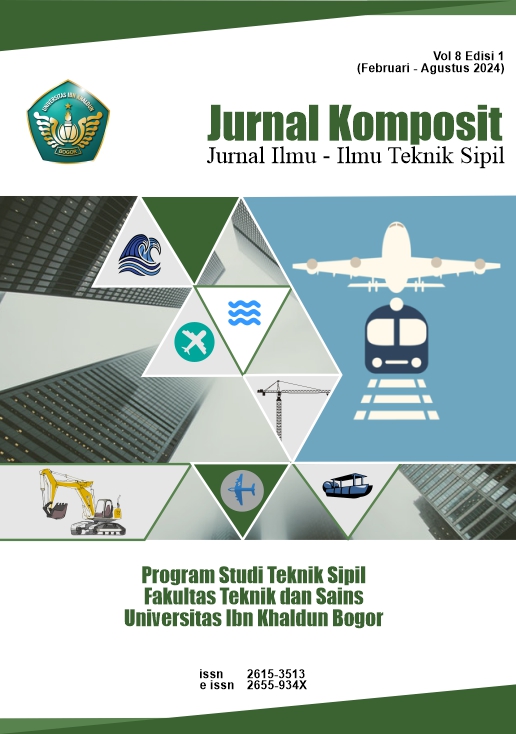Analisis Risiko Pekerjaan Erection Jembatan Kereta Api Menggunakan Metode Fuzzy FMEA
DOI:
https://doi.org/10.32832/komposit.v8i1.15165Keywords:
Risk Identification, Risk Assesment, Risk Mitigation, Mode and Effect Analysis, Failure Mode and Effect Analysis, Fuzzy Failure Mode and Effect AnalysisAbstract
The Solo-Semarang dual railway line project is considered to have a high risk of danger because it is located very close to level crossings and becomes a meeting between seven roads so that it can endanger residents and the environment as well as project workers who are in the project area. The purpose of this study is to conduct a risk assessment using the Fuzzy Failure Mode And Effect Analysis (FMEA) method of hazards or potential incidents in railroad bridge erection work. The Fuzzy FMEA method is used to identify work accident risks and determine risk mitigation priorities based on the highest Fuzzy RPN (Risk Priority Number) value. The results of the research conducted from March - April 2023 obtained 14 (fourteen) risks obtained from observations and Job Safety Analysis documents. Based on the processing results, the highest Fuzzy RPN value was obtained in the erection work of 500 (five hundred) for the risk of machine damage. This value is in the high category so that risk mitigation actions are needed to prevent and reduce the impact of risks.
References
Alpan, D. B. (2017). Hazard Identification Risk Asessessment Risk Control pada Tahap Pemasangan Precast Fasade di Wika Cakra KSO Tahun 2017 [Universitas Binawan]. https://repository.binawan.ac.id/617/
Astuti, S. W., Alfariji, M. D., Armyta, A., & Prativi, A. (2022). Efforts To Prevent Work Accidents with Failure Mode and Effect Analysis (FMEA) Method. Journal of World Science, 1(11), 1077–1093. https://doi.org/10.58344/jws.v1i11.145
Direktorat Jenderal Bina Konstruksi. (2016). Manajemen Risiko K3. Direktorat Jenderal Bina Konstruksi, Kementrian Pekerjaan Umum dan Penataan Ruang.
Giri, J. P., Alit, I. K., Putra, A., & Mahendra, I. W. (2021). Identifikasi Penilaian dan Mitigasi Resiko pada Proyek Villa Nini Elly. Jurnal Teknik Gradien, 13(01), 61–73.
Kangari, R. (1995). Risk management perceptions and trends of US construction. Journal of Construction Engineering and Management, 121(4), 422-429. https://doi.org/10.1061/(ASCE)0733-9364(1995)121:4(422)
Puente, J. (2012). Artificial Intellegence Tools for Applying Failure Mode and Effect Analysis (FMEA). International Journal of Quality & Reliability Management, 19(1), 137–143.
Puspitaloka, M. A. C. D., & Ekawati, Y. (2022). Analisis Perbaikan Kualitas Proses Produksi di PT. XYZ dengan Menggunakan Metode Fuzzy FMEA. Jurnal Teknik Industri UMC, 2(1), 14–26. https://doi.org/10.33479/jtiumc.v2i1.19
Sugiyono, S. (2014). Metode Penelitian Pendidikan Pendekatan Kuantitatif, Kualitatif, dan R&D. Alfabeta.
Suhatmaja, R., Chayati, N., & Taqwa, F. M. L. (2018). Analisis Risiko dalam Pekerjaan Atap Stadion Renang Aquatic Senayan. Prosiding Seminar Nasional Pascasarjana, Departemen Teknik Sipil FT-UI, Depok, August, 376–382
Sukwadi, R., Wenehenubun, F., & Wenehenubun, T. W. (2017). Pendekatan Fuzzy FMEA dalam Analisis Faktor Risiko Kecelakaan Kerja. Jurnal Rekayasa Sistem Industri, 6(1), 29. https://doi.org/10.26593/jrsi.v6i1.2425.29-38
Suriyanto, S., Profita, A., & Saptaningtyas, W. W. E. (2022). Penilaian Risiko Pada PDAM Tirta Kencana dengan Metode Fuzzy Failure Mode and Effects Analysis. Journal of Industrial and Manufacture Engineering, 6(2), 238–247. https://doi.org/10.31289/jime.v6i2.8311
Yeni, S. F., Masril, M., & Dewi, S. (2022). Analisis Manajemen Risiko terhadap Pelaksanaan Pembangunan Konstruksi Gedung Bertingkat di Kabupaten Dhamasraya. Ensiklopedia Research and Community Service Review, 1(2), 96–101. https://doi.org/10.33559/err.v1i2.1131
Downloads
Published
How to Cite
Issue
Section
License
Copyright (c) 2024 Jurnal Komposit: Jurnal Ilmu-ilmu Teknik Sipil

This work is licensed under a Creative Commons Attribution-NonCommercial-ShareAlike 4.0 International License.
Authors who publish with this journal agree to the following terms (Penulis yang mengajukan publikasi artikel telah menyetujui hal berikut):
- Through this publication, the author agree to submit the copyright of article writing to Jurnal Komposit: Jurnal Ilmu-ilmu Teknik Sipil. This copyright submission takes the form of, but is not limited to: reproduction of the article and parts therein, including photographic reproductions; distribution of articles through printed and electronic documents; and translation of articles(Bahwa melalui publikasi ini, hak cipta penulisan artikel diserahkan kepada Jurnal Komposit: Jurnal Ilmu-ilmu Teknik Sipil. Penyerahan hak cipta ini berupa, namun tidak terbatas pada: perbanyakan artikel dan bagian di dalamnya, termasuk reproduksi fotografi; penyebarluasan artikel melalui dokumen cetak dan elektronik; serta penterjemahan artikel).
- The authors agree to the terms of the Copyright Notice, according to Creative Commons Attribution-NonCommercial-ShareAlike 4.0 International License., which will apply to this article if and when it is published by Jurnal Komposit: Jurnal Ilmu-ilmu Teknik Sipil. (Para penulis setuju dengan ketentuan Pemberitahuan Hak Cipta, sesuai dengan Lisensi Internasional Creative Commons Attribution-NonCommercial-ShareAlike 4.0., yang akan berlaku untuk artikel ini jika dan ketika diterbitkan oleh Jurnal Komposit: Jurnal Ilmu-ilmu Teknik Sipil).

This work is licensed under a Creative Commons Attribution-NonCommercial-ShareAlike 4.0 International License.



.png)










